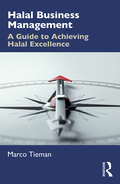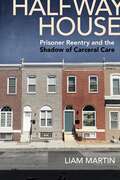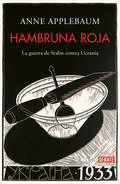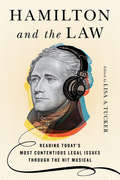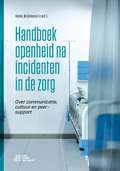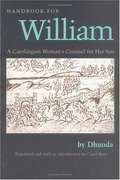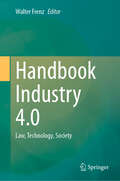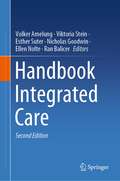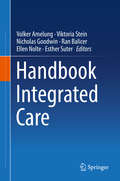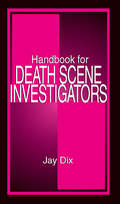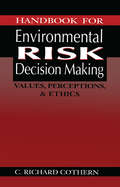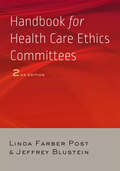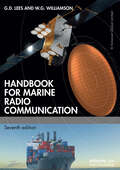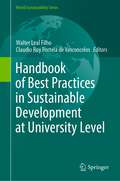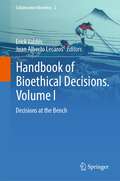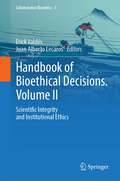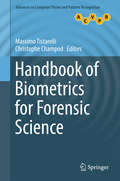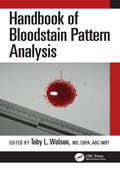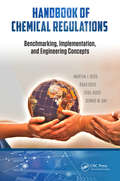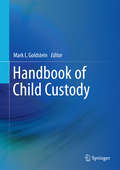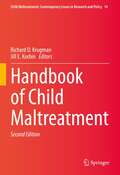- Table View
- List View
Halal Business Management: A Guide to Achieving Halal Excellence
by Marco TiemanThe halal industry is a fast-growing industry due to demographics and industry expansion. Halal certification of products, outlets, and services is essential for doing business in Muslim-majority countries. This book shares the building blocks of professional halal business management, covering halal certification, halal supply chain management, branding and marketing, and halal risk and reputation management. Drawing on years of academic research and advisory experience, the book provides practical advice and guidance on how best to organise and upscale your halal business operations. Successful companies in the halal industry are those that embrace halal excellence by design. Halal excellence is a process – a pursuit of excellence. Halal business management is beyond halal certification, and needs to address supply chain management, branding and marketing, and risk and reputation management. Halal excellence needs measurement through adopting the right key performance indicators, to protecting your halal reputation and licence to operate in Muslim markets. This book gives proven, practical strategies to guide you in the halal industry. The book is for all organisations involved in serving Muslim markets, and also serves as a coursebook for graduate and postgraduate education in halal business management.
Halfway House: Prisoner Reentry and the Shadow of Carceral Care (Alternative Criminology #26)
by Liam MartinAn inside look at the struggles former prisoners face in reentering society Every year, roughly 650,000 people prepare to reenter society after being released from state and federal prisons. In Halfway House, Liam Martin shines a light on their difficult journeys, taking us behind the scenes at Bridge House, a residential reentry program near Boston, Massachusetts. Drawing on three years of research, Martin explores the obstacles these former prisoners face in the real world. From drug addiction to poverty, he captures the ups and downs of life after incarceration in vivid, engaging detail. He shows us what, exactly, it is like to live in a halfway house, giving us a rare, up-close view of its role in a dense and often confusing web of organizations governing prisoner reentry. Martin asks us to rethink the possibilities—and pitfalls—of using halfway houses to manage the worst excesses of mass incarceration. A portrait of life in the long shadow of the carceral state, Halfway House lets us see the struggles of reentry through the eyes of former prisoners.
Hambruna roja: La guerra de Stalin contra Ucrania
by Anne ApplebaumLa ganadora del Premio Pulitzer Anne Applebaum arroja luz sobre uno de los más atroces genocidios de la historia de Europa. En 1929, la gran colectivización puesta en marcha por Stalin forzó a millones de campesinos a entregar el control de sus tierras consolidando así la explotación estatal y el fortalecimiento del régimen soviético. Esta "política" resultó en una hambruna de proporciones trágicas: al menos 5 millones de personas perecieron entre 1931 y 1933 en la URSS, de la cuales 3 millones eran ucranianas. En Hambruna roja, Anne Applebaum argumenta que esas muertes no fueron accidentales, ni consecuencias colaterales de una mala política pública, sino absolutamente deliberadas y planeadas. Definitivo y devastador, este libro captura el horror de gente ordinaria luchando por sobrevivir un mal extraordinario. Reseñas:«Un vívido testigo que expone los mitos sobre la catastrófica hambruna que sufrió Ucrania entre 1932 y 1933.»The Guardian. «Cómo Stalin mató de hambre a un pueblo: una poderosa historia que deja al descubierto la maldad y la estupidez que acabó con la vida de millones de ucranianos.»Daniel Finkelstein, The Times. «Applebaum ha se ha servido meticulosamente de una enorme selección de fuentes, muchas de las cuales no estaban disponibles cuando el historiador Robert Conquest escribió su pionera historia de la hambruna, La cosecha del dolor, hace ya 30 años.»The New York Times.
Hamilton and the Law: Reading Today's Most Contentious Legal Issues through the Hit Musical
Since its Broadway debut, Hamilton: An American Musical has infused itself into the American experience: who shapes it, who owns it, who can rap it best. Lawyers and legal scholars, recognizing the way the musical speaks to some of our most complicated constitutional issues, have embraced Alexander Hamilton as the trendiest historical face in American civics. Hamilton and the Law offers a revealing look into the legal community's response to the musical, which continues to resonate in a country still deeply divided about the reach of the law. A star-powered cast of legal minds—from two former U.S. solicitors general to leading commentators on culture and society—contribute brief and engaging magazine-style articles to this lively book. Intellectual property scholars share their thoughts on Hamilton's inventive use of other sources, while family law scholars explore domestic violence. Critical race experts consider how Hamilton furthers our understanding of law and race, while authorities on the Second Amendment discuss the language of the Constitution's most contested passage. Legal scholars moonlighting as musicians discuss how the musical lifts history and law out of dusty archives and onto the public stage. This collection of minds, inspired by the phenomenon of the musical and the Constitutional Convention of 1787, urges us to heed Lin-Manuel Miranda and the Founding Fathers and to create something new, daring, and different.
Hammelsprung: Geschichte und Parlamentspraxis
by Hans-Joachim Berg Michael F. FeldkampIn diesem Buch wird die historische Entwicklung und Begriffsgeschichte des Hammelsprungs als eines der bemerkenswertesten sichtbaren Instrumente der Parlamentsarbeit seit dem 19. Jahrhundert dargestellt. Ferner wird gezeigt, dass die tatsächliche Handhabung des Hammelsprungs der ursprünglichen parlamentsrechtlichen Intention und modernen Funktionalität nicht mehr gerecht wird. Anträge in den Landesparlamenten von Bayern und Berlin schlagen eine Umkehr des bisherigen Auszählverfahrens vor. Danach soll die Zählung nicht erst bei Wiedereintritt in den Plenarsaal, sondern bereits beim Verlassen erfolgen.
Handboek openheid na incidenten in de zorg: Over communicatie, cultuur en peer-support
by Hans BrölmannDit boek draagt bij aan de implementatie van open communicatie door zorgverleners na incidenten of bij klachten. Een open en eerlijk gesprek met patiënten en hun naasten helpt bij het sneller en beter verwerken van de traumatische ervaring, door zowel patiënt als zorgverlener. Het brengt de essentie van openheid na incidenten in kaart en bespreekt de kernelementen van het open gesprek. Het is bedoeld voor iedereen in de zorg die met incidenten, calamiteiten en klachten te maken heeft of kan krijgen. En is daardoor ook waardevol voor cliënten, patiënten en hun naasten.
Handbook For William: A Carolingian Women's Counsel For Her Son (Medieval Texts In Translation Series)
by Dhuoda Carol NeelSo wrote the Frankish noblewoman Dhuoda to her young son William in the middle of the ninth century. Intended as a guide to right conduct, the book was to be shared in time with William's younger brother. Dhuoda's situation was poignant. Her husband, Bernard, the count of Septimania, was away and she was separated from her children. William was by Charles the Bald as a guarantee of his father's loyalty, and the younger son's whereabouts were unknown. As war raged in the crumbling Carolingian Empire, the grieving mother, fearing for the spiritual and physical welfare of her absent sons, began in 841 to write her loving counsel in a handbook. Two years later she sent it to William. Handbook for William memorably expresses Dhuoda's maternal feelings, religious fervor, and learning. In teaching her children how they might flourish in God's eyes, as well as humanity's, Dhuoda reveals the authority of Carolingian women in aristocratic households. She dwells on family relations, social order, the connection between religious and military responsibility, and, always, the central place of Christian devotion in a noble life. One of the few surviving texts written by a woman in the Middle Ages, Dhuoda's Liber manualis was available in only two faulty Latin manuscripts until a third, superior one was discovered in the 1950s. This English translation is based on the 1975 critical edition and French translation by Pierre Riché. Now available for the first time in paperback, it includes an afterword written by Carol Neel that takes into account recent scholarship and the 1991 revised edition of Riché's text.
Handbook Industry 4.0: Law, Technology, Society
by Walter FrenzThe handbook presents an overview of Industry 4.0 and offers solutions for important practical questions. The law and its current challenges regarding data assignment (who owns the data? / EU guidelines), data security, data protection (General Data Protection Regulation), cyberattacks, competition law (right to access vs. monopolists, permissible and prohibited exchanges of information, possible collaborations) is the point of departure. In turn, the book explores peculiarities in specific areas of Industry 4.0 (Internet of Production, mechanical engineering, artificial intelligence, electromobility, autonomous driving, traffic, medical science, construction, energy industry, etc.). The book’s closing section addresses general developments in management, the digital transformation of companies and the world of work, and ethical questions.
Handbook Integrated Care
by Volker Amelung Viktoria Stein Nicholas Goodwin Ran Balicer Ellen Nolte Esther SuterThis handbook shares profound insights into the main principles and concepts of integrated care. It offers a multi-disciplinary perspective with a focus on patient orientation, efficiency, and quality by applying widely recognized management approaches to the field of healthcare. The handbook also highlights international best practices and shows how integrated care can work in various health systems. In the majority of health systems around the world, the delivery of healthcare and social care is characterised by fragmentation and complexity. Consequently, much of the recent international discussion in the fields of health policy and health management has focused on the topic of integrated care. “Integrated” acknowledges the complexity of patients’ needs and aims to meet them by taking into account both health and social care aspects. Changing and improving processes in a coordinated way is at the heart of this approach. The second edition offers new chapters on people-centredness, complexity theories and evaluation methods, additional management tools and a wealth of experiences from different countries and localities. It is essential reading both for health policymakers seeking inspiration for legislation and for practitioners involved in the management of public health services who want to learn from good practice.
Handbook Integrated Care
by Volker Amelung, Viktoria Stein, Nicholas Goodwin, Ran Balicer, Ellen Nolte and Esther SuterThis handbook gives profound insight into the main ideas and concepts of integrated care. It offers a managed care perspective with a focus on patient orientation, efficiency, and quality by applying widely recognized management approaches to the field of health care. The handbook also provides international best practices and shows how integrated care does work throughout various health systems. The delivery of health and social care is characterised by fragmentation and complexity in most health systems throughout the world. Therefore, much of the recent international discussion in the field of health policy and health management has focused on the topic of integrated care. “Integrated” acknowledges the complexity of patients´ needs and aims to meet it by taking into account both health and social care aspects. Changing and improving processes in a coordinated way is at the heart of this approach.
Handbook for Death Scene Investigators
by Jay DixHandbook for Death Scene Investigators provides concise information in a handy, pocket-sized (3 1/2" x 6") format - perfect for on-the-scene reference.Details about sudden natural deaths by disease and accidents are emphasized in this guidebook, complemented with practical information on:reviewing a medical chartcollecting evidenceobtaining a medic
Handbook for Environmental Risk Decision Making: Values, Perceptions, and Ethics
by C. Richard CothernThis handbook describes the broad aspects of risk management involving scientific policy judgment, uncertainty analysis, perception considerations, statistical insights, and strategic thinking. This book presents all the important concepts to enable the reader to "see the big picture." This ability is extremely important - it allows the decision ma
Handbook for Health Care Ethics Committees
by Jeffrey Blustein Linda Farber PostHow can dedicated ethics committees members fulfill their complex roles as moral analysts, policy reviewers, and clinical consultants?The Joint Commission (TJC) accredits and certifies more than 19,000 health care organizations in the United States, including hospitals, nursing homes, and home care agencies. Each organization must have a standing health care ethics committee to maintain its status. These interdisciplinary committees are composed of physicians, nurses, attorneys, ethicists, administrators, and interested citizens. Their main function is to review and provide resolutions for specific, individual patient care problems. Many of these committees are well meaning but may lack the information, experience, skills, and formal background in bioethics needed to adequately negotiate the complex ethical issues that arise in clinical and organizational settings.Handbook for Health Care Ethics Committees was the first book of its kind to address the myriad responsibilities faced by ethics committees, including education, case consultation, and policy development. Adopting an accessible tone and using a case study format, the authors explore serious issues involving informed consent and refusal, decision making and decisional capacity, truth telling, the end of life, palliative care, justice in and access to health care services, and organizational ethics.The authors have thoroughly updated the content and expanded their focus in the second edition to include ethics committees in other clinical settings, such as long-term care facilities, small community hospitals, rehabilitation centers, and hospices. They have added three new chapters that address reproduction, disability, and the special needs of the elder population, and they provide additional specialized policies and procedures on the book’s website. This guide is an essential resource for all health care ethics committee members.
Handbook for Health Care Ethics Committees
by Jeffrey Blustein Linda Farber PostHow can dedicated health care ethics committees increase their effectiveness and demonstrate their value as essential moral resources for their organizations?Among the most effective and increasingly valued resources in the health care decision-making process is the institutional ethics committee. The Joint Commission (TJC) accredits and certifies more than 19,000 health care organizations in the United States, including hospitals, nursing homes, and home care agencies. As a condition of accreditation, TJC requires health care organizations to have available a standing multidisciplinary ethics committee, composed of physicians, nurses, attorneys, ethicists, administrators, and interested lay citizens. Many of these committees are well meaning but may lack the information, experience, skills, and formal background in bioethics needed to effectively address the range and complexity of the ethical issues that arise in clinical and organizational settings.Handbook for Health Care Ethics Committees was conceived in 2007 to address the myriad responsibilities assumed by ethics committees. Using sample cases and accessible language, Linda Farber Post and Jeffrey Blustein explored applied bioethics, including informed consent and refusal, decision making and decisional capacity, truth telling, care at the beginning and end of life, palliation, justice in and access to health care services, and organizational ethics.In the third edition, Post and Blustein have thoroughly updated and reorganized the content and expanded the scope of the material, with special attention to changes in the health care landscape since the second edition was published in 2015. They also focus on communication between and among patients, care providers, and families, the demands of professionalism, the essential role that ethics committees can and should play, and how their effectiveness and value can be assessed. An entirely new chapter examines research ethics. The book also addresses the challenging ethical issues raised by the ongoing COVID-19 pandemic. This guide remains an essential resource for all health care ethics committee and their members.
Handbook for Marine Radio Communication
by G.D. Lees W.G. WilliamsonThis bestselling book provides an incomparable reference source for all vessels using maritime radio communication systems, which are now a legislative requirement. It includes exhaustive coverage of all UK and international regulations relating to modern maritime communications, such as the crucial GMDSS, all contained within one singular volume. This sixth edition has been fully updated to take into account major developments over the last five years, in particular the revised regulations introduced by the International Telecommunication Union in 2012. The authors deliver an authoritative guide to the complicated and changing world of radio communications, including: The very latest technological advances in terrestrial and satellite communications Changes to the international VHF channel allocation and channel spacing The major overhaul of the organisational structure of the UK Coastguard service Substantial enhancements to the eLoran services The changing complexities of voyage planning Large diagrams, an extensive index and fully-updated appendices This is a definitive guide for today’s maritime communications industry, including ship owners, ship managers, coast guards, seafarers, students of maritime communications, as well as the recreational sector.
Handbook for Marine Radio Communication
by G.D. Lees W.G. WilliamsonNow in its seventh edition, this bestselling Handbook for Marine Radio Communication provides an incomparable reference source for all vessels using maritime radio communication systems, which are now a legislative requirement. It includes exhaustive coverage of all UK and international regulations relating to modern maritime communications, such as the crucial GMDSS, all contained within one singular volume. This edition has been fully updated to account for recent major developments in the field. The authors deliver an authoritative guide to the complicated and changing world of radio communications, including: • Information refl ecting ITU Radio Regulations 2020 • Impending modernisation of the GMDSS • Radical changes to maritime satellite communications and associated distress and safety services • Introduction of VHF data exchange system (VDES) to supplement coastal AIS services • Introduction of navigational data (NAVDAT) to supplement NAVTEX services • Improvements to COSPAS/SARSAT systems • Introduction of AIS facility to EPIRBs • Automatic link establishment (ALE) on HF bands • Updating of global navigation satellite systems (GNSS) • UK explanatory memorandum to the Merchant Shipping (Radiocommunications) (Amendment) Regulations 2021. This is a definitive guide for today’s maritime communications industry, including ship owners, ship managers, coast guards, seafarers, students of maritime communications, as well as the recreational sector.
Handbook of Agri-Food Law in China, Germany, European Union: Food Security, Food Safety, Sustainable Use of Resources in Agriculture
by Ines HärtelThis book offers a new and differentiated overview of Agri-Food Law against the background of national and global integration of markets, and compares for the first time important aspects of the agricultural, environmental and food law of China and Germany / the European Union. In addition to the basics, it discusses a wide range of issues, such as the respective legal regulatory structures for food security, food safety, geographical indications of origin, climate protection, fertilizers, plant protection products, genetic engineering, water protection, soil protection, land resources and organic farming. In addition, it addresses key environmental impacts and developments in order to create integrated value chains. The increasing fusion of upstream and downstream areas is becoming apparent from primary production, to the refinement and trade up level, and even to consumption. Agri-Food Law is now productively taking these important developments into account with regard to the aforementioned countries.
Handbook of Best Practices in Sustainable Development at University Level (World Sustainability Series)
by Walter Leal Filho Claudio Ruy Portela de VasconcelosThis book gives a special emphasis to state-of-the-art descriptions of approaches, methods, initiatives, and projects from universities, stakeholders, organizations, and civil society across the world, regarding cross-cutting issues in sustainable development.There is a perceived need for mobilizing the various stakeholders when attempting to promote sustainability in higher education and to promote best practices, which may inspire further initiatives. But despite this need, there are a few publications handling this matter in a coherent way. In order to meet the pressing need for publications which may document and disseminate examples of best practice on sustainable development at university level, the “Handbook of Best Practices in Sustainable Development at University Level” is being published.This book is produced by the European School of Sustainability Science and Research (ESSSR), through the Inter-University Sustainable Development Research Programme (IUSDRP) and contains inputs from authors across all geographical regions.The book also discusses examples of initiatives coordinated by universities but involving civil society, the private sector, and public sector (including local, national, and intergovernmental bodies). In particular, it describes practical experiences, partnerships, networks, and training schemes for building capacity aimed at fostering the cause of sustainable development at institutions of higher education.Thanks to its design and the contributions by experts from various areas, it provides a welcome contribution to the literature on sustainable development, and it may inspire further works in this field.
Handbook of Bioethical Decisions. Volume I: Decisions at the Bench (Collaborative Bioethics #2)
by Erick Valdés Juan Alberto LecarosThe Handbook of Bioethical Decisions is aimed at addressing and analyzing the most important ethical concerns and moral quandaries arisen in biomedical and scientific research. As such, it identifies and problematizes on a comprehensive range of ethical issues researchers must deal with in different critical contexts. Thus, the Handbook, Vol. I, may be helpful for them to make decisions and deliberate in complex practical scenarios. In this fashion, the volume reunites different points of view to give readers room enough to get a better knowledge and take their own position on pressing bioethical issues of the day. Consequently, this work seeks to engender dense ethical epistemology scientists can count on when conducting latest generation biomedical research. By bringing together an impressive array of contributions on the most important elements and categories for “at the bench” bioethical decisions as well as offering chapters by some of the most world renowned and prominent experts in bioethics, the Handbook, Vol. I, is a paradigmatic text in its area and a valuable resource for courses on bioethics, and biomedical research, as well as courses that discuss ethics and the biosciences at different professional levels, biomedical industry, pharmacological companies and the public sphere in general.
Handbook of Bioethical Decisions. Volume II: Scientific Integrity and Institutional Ethics (Collaborative Bioethics #3)
by Erick Valdés Juan Alberto LecarosThe Handbook of Bioethical Decisions Volume II addresses and analyzes the most important ethical concerns and moral quandaries related to scientific integrity and institutional ethics. It counts on two parts, Part One: Research Ethics, which addresses issues related to Scientific Integrity, Research Misconduct and Conducting Ethical Research, and Part Two: Institutional Ethics and Bioethics Committees, which explores Institutional Ethics issues, Ethics and Bioethics Committees’ roles and scopes, and Bioethical Issues in Institutional Ethics. Consequently, the Handbook, Vol. II, offers a remarkable collection of works by outstanding international experts on institutional and research ethics, in order for bioethics practitioners to obtain better elements to address key issues related to integrity in research as well as to decision-making processes. In this fashion, this volume is a valuable resource for professionals working on different bioethical and biomedical fields, such as, ethics and bioethics committees, health care institutions, biomedical and pharmacological companies, and academic settings, among others.Chapter 26 is available open access under a Creative Commons Attribution 4.0 International License via link.springer.com.
Handbook of Biometrics for Forensic Science
by Massimo Tistarelli Christophe ChampodThis comprehensive handbook addresses the sophisticated forensic threats and challenges that have arisen in the modern digital age, and reviews the new computing solutions that have been proposed to tackle them. These include identity-related scenarios which cannot be solved with traditional approaches, such as attacks on security systems and the identification of abnormal/dangerous behaviors from remote cameras. Features: provides an in-depth analysis of the state of the art, together with a broad review of the available technologies and their potential applications; discusses potential future developments in the adoption of advanced technologies for the automated or semi-automated analysis of forensic traces; presents a particular focus on the acquisition and processing of data from real-world forensic cases; offers an holistic perspective, integrating work from different research institutions and combining viewpoints from both biometric technologies and forensic science.
Handbook of Bloodstain Pattern Analysis
by Toby L. WolsonThe Handbook of Bloodstain Pattern Analysis captures the latest understanding of the science that supports bloodstain pattern analysis (BPA) and includes the results of numerous research studies using modern technologies not found in previously published books. It provides the BPA community with a modern, up-to-date reference and training manual to outline and validate the utility, repeatability, and reliability of BPA science.BPA has recently been presented in the news media as an example of “junk” science used in a handful of cases involving wrongful convictions. However, the reality is that the primary issue for BPA in these wrongful convictions is not the science: it is the result of substandard training and the lack of experience of BPA analysts, prior to beginning casework and testifying in court as experts. As such, this book is written to serve as an essential study guide for analysts preparing to sit for the International Association for Identification (IAI) Bloodstain Pattern Analyst Certification exam. The contents of the book are guided by the ANSI/ASB Standards for a Bloodstain Pattern Analysis Training Program. Each chapter has been written by top experts conversant on the relevant BPA, BPA terminology, forensic science, physics, fluid dynamics, crime scene analysis, education/training, bias, and current relevant legal considerations for use of BPA in court.Handbook of Bloodstain Pattern Analysis is the most up-to-date resource on BPA currently available, providing a definitive training manual for practitioners, and an essential reference for forensic pathologists, police investigators, crime scene investigators, attorneys, and students enrolled in forensic science university courses.
Handbook of Chemical Regulations: Benchmarking, Implementation, and Engineering Concepts
by Martha J. Boss Brad Boss Cybil Boss Dennis W. DayThe first book of its kind, Handbook of Chemical Regulations: Benchmarking, Implementation, and Engineering Concepts introduces the concept of global harmonization and interlinks between regulations and examines the reasons behind major requirements for chemical manufacture, article production, and distribution, importation, and usage. A compendium
Handbook of Child Custody
by Mark L. GoldsteinThis authoritative reference brings together leading experts for up-to-date theory, findings, and guidelines on the core aspects of child custody evaluations. Contributors offer steps for gathering more accurate family data through home observations, interviews, and collateral information. Chapters examine psychological assessment tools commonly used in evaluations, including measures relating to parenting competencies, mental illness, domestic violence, and substance abuse, and consider increasingly salient issues such as relocation and families in therapy. The section on case studies shows best practices applied in real-life custody situations, and a chapter authored by a family court judge offers rarely-seen perspective from the bench. Featured in the Handbook: · A survey of ethical and professional issues. · Observing and interviewing children, adolescents, and adults. · Psychological assessment and personality testing. · A detailed review of the Bricklin scales. · Specialized issues, including parental alienation, attachment, cults, and more. · Illustrative case studies and psychological reports. Mental health professionals who conduct child custody evaluations, including psychiatrists, clinical psychologists clinical social workers, family and marriage counselors, and licensed clinical professional counselors, will appreciate the Handbook of Child Custody. Family law attorneys will also find the Handbook useful in assisting them in child custody litigation. Its thorough coverage will aid evaluators in making recommendations that are professional, ethical, and impartial, and family lawyers in understanding the evaluation process and preparing for expert testimony.
Handbook of Child Maltreatment (Child Maltreatment #14)
by Richard D. Krugman Jill E. KorbinThe second edition of this successful handbook, edited by well-known experts in this field, includes core questions in the field of child abuse and neglect. It addresses major challenges in child maltreatment work, starting with “What is child abuse and neglect?” and then examines why maltreatment occurs and what are its consequences. The handbook also addresses prevention, intervention, investigation, treatment as well as civil and criminal legal perspectives. It comprehensively studies the issue from the perspective of a broader, international and cross-cultural human experience. Apart from a thorough revision of existing chapters, this edition includes many new chapters covering recent developments in this area and other issues not covered in the first edition. There is more focus on substance abuse, psychological abuse, and on social and community involvement and public health provisions in the prevention of child maltreatment. The handbook examines what is known now and more importantly what remains to be researched in the coming decades to help abused and neglected children, their families and their communities, thereby taking the field forward.
